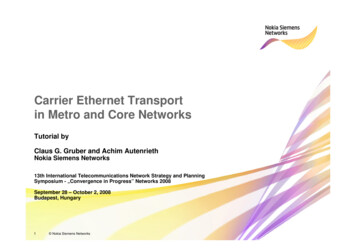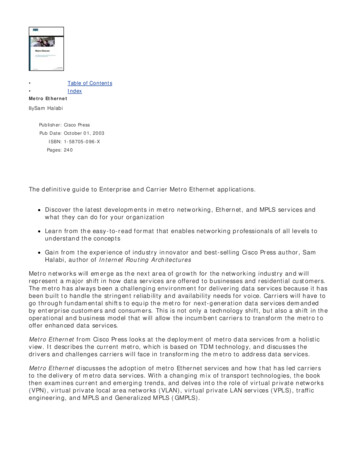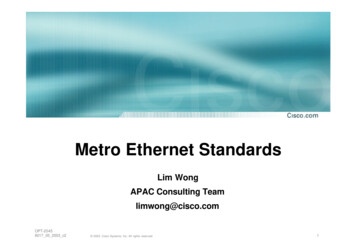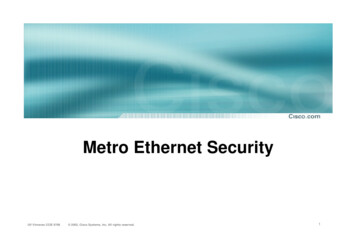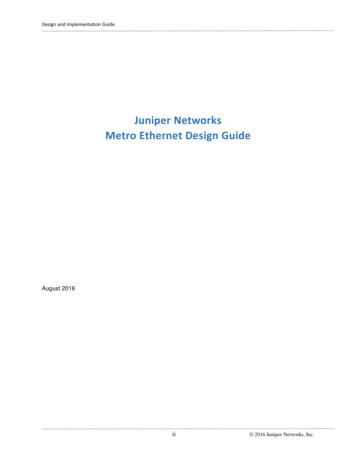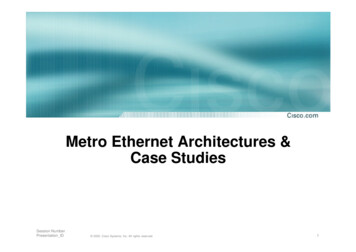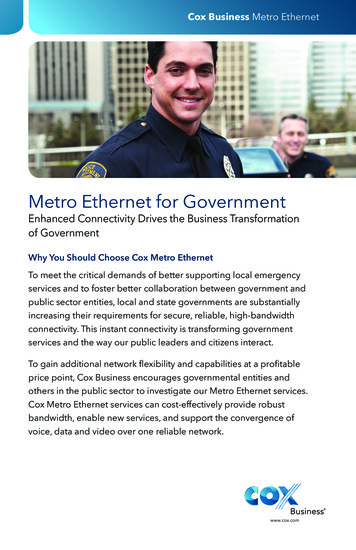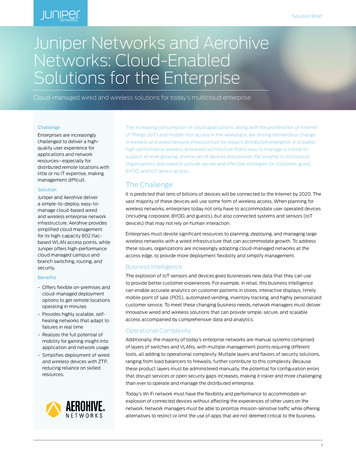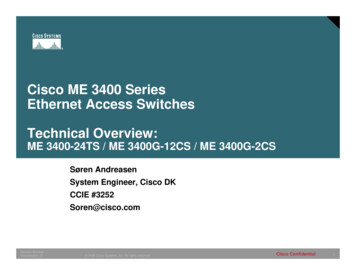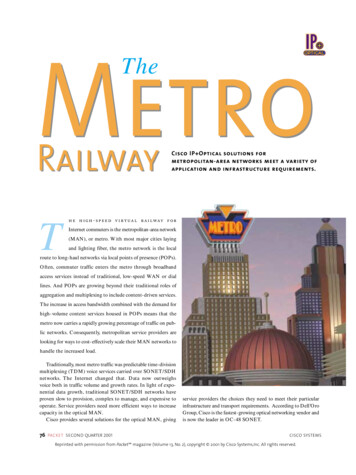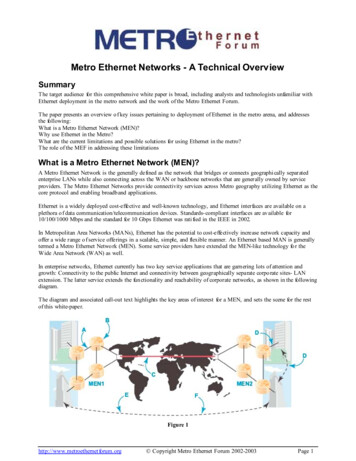
Transcription
Metro Ethernet Networks - A Technical OverviewSummaryThe target audience for this comprehensive white paper is broad, including analysts and technologists unfamiliar withEthernet deployment in the metro network and the work of the Metro Ethernet Forum.The paper presents an overview of key issues pertaining to deployment of Ethernet in the metro arena, and addressesthe following:What is a Metro Ethernet Network (MEN)?Why use Ethernet in the Metro?What are the current limitations and possible solutions for using Ethernet in the metro?The role of the MEF in addressing these limitationsWhat is a Metro Ethernet Network (MEN)?A Metro Ethernet Network is the generally defined as the network that bridges or connects geographi cally separatedenterprise LANs while also connecting across the WAN or backbone networks that are generally owned by serviceproviders. The Metro Ethernet Networks provide connectivity services across Metro geography utilizing Ethernet as thecore protocol and enabling broadband applications.Ethernet is a widely deployed cost-effective and well-known technology, and Ethernet interfaces are available on aplethora of data communication/telecommunication devices. Standards-compliant interfaces are available for10/100/1000 Mbps and the standard for 10 Gbps Ethernet was rati fied in the IEEE in 2002.In Metropolitan Area Networks (MANs), Ethernet has the potential to cost-effectively increase network capacity andoffer a wide range of service offerings in a scalable, simple, and flexible manner. An Ethernet based MAN is generallytermed a Metro Ethernet Network (MEN). Some service providers have extended the MEN-like technology for theWide Area Network (WAN) as well.In enterprise networks, Ethernet currently has two key service applications that are garnering lots of attention andgrowth: Connectivity to the public Internet and connectivity between geographically separate corporate sites- LANextension. The latter service extends the functionality and reachability of corporate networks, as shown in the followingdiagram.The diagram and associated call-out text highlights the key areas of interest for a MEN, and sets the scene for the restof this white-paper.Figure 1http://www.metroethernet forum.org Copyright Metro Ethernet Forum 2002-2003Page 1
Metro Ethernet Netw orks – A Technical Overviewv2.0Links are primarily point-to-point and can be any speed of Ethernet.Nodes can be either switches or routers, depending on:- Their location in the MEN- The nature of the services being provisioned- The level of service resilience (network protection)Nodes are meshed to whatever degree necessary to provide the desired connectivity, services and protectionWAN links connect MEN’s together across large distances.Ethernet Services can be topologically classified into either E-Line (point-to-point as shown), or E-LAN (multipoint-tomultipoint). Services can be further classi fied according to the bandwidth provisioned and which can be exclusive orshared across multiple users. Bandwidth can be provisioned on demand e.g. from 1Mbps to 1Gbps.Varying degrees of service resilience is obtained by implementing a combination of network protection techniqueswhich can be end-to-end (as shown) or nodalQuality of Service (QoS) is obtained by using a combination of techniques, providing both ‘hard’ and ‘soft’ bandwidthand packet-loss guarantees. QoS can be end-to-end (as shown) nodal. QoS is visible from an enterprise end-customerperspective as a technical/operational Service Level Specifi cation (SLS), which is underwritten by a commercialService Level Agreement (SLA)Why use Ethernet in the Metro anyway?Today, 98 percent of all data traffi c in all enterprise LANs start and end on an Ethernet port. It is the most dominantstandard protocol in the networking industry and has 30 years of great history in the Enterprise LANs. As enterprisesare looking for network connectivity beyond the walls of their LANs, Metro Ethernet becomes an obvious choice botha technical and cost perspective.When corporate networks are connected to, or interconnected within a MAN, a bottleneck can be created. Indeed, theso-called ‘bandwidth glut’ of which analysts often speak is diffi cult to find in the Metro – as here, connections aredominated by often traditional T1/E1, T3/E3 or ATM links. Over the last decade bandwidth has increased over 300 foldin the backbone and 100 fold in the access, but only a meager 16 fold in the metro producing a significant Metrobottleneck. Enterprise customers are pushing service providers to connect their sites via metro networks, yet T1 linesoft en cannot provide the fl exible metro bandwidth capacity that enterprises know Optical Ethernet can provide.Deploying Gigabit Ethernet based platforms in the metropolitan areas is a compelling and commercially provenapproach to break the metro bandwidth bottleneck for the following reasons:Cost EffectivenessInfrastructure equipment costs for Ethernet are significantly less than frame relay (FR) or ATM costs. This is due to:(a) The economies-of-s cale arising from the existing installed base of Ethernet that ensures lower materi al anddevelopments costs(b) The relative technical simplicity of Ethernet.Further, the economics on Ethernet have held true over the 30 year lifetime of Ethernet – where the ‘rule of thumb’ hasbeen: “Roughly ten times the performance of the preceding generation, at about three times the cost.”Provisioning costs (mainly operational and planning related) are also significantly less than for TDM (T1/E1, T3/E3,SONET / SDH) with comparatively effortless adoption and higher available data rates as an added bonus.Rapid Provisioning on DemandFrom a service provider perspective, service velocity is a key competitive differentiator. The present lack of customercentric flexibility as well as the coarseness of bandwidth granul arity of TDM and ATM legacy systems are seen to bemajor impediments to providing promising revenue generating services such as described in section 6. Today, theprevalent connection choices are DS1, DS3, OC3, etc - and the flexibility and fine granularity required by many ITmanagers running corporate networks, is often simply not available.On the other hand, Ethernet access services offer a wide range of speeds, from 1Mbps to 1Gbps, in increments ofhttp://www.metroethernet forum.org Copyright Metro Ethernet Forum 2002-2003Page 2
Metro Ethernet Netw orks – A Technical Overviewv2.01Mbps or less, which can be provided on-demand and quickly – possibly even by the customer through a web-basedtool.Packet-basedEthernet is an asynchronous frame-based technology that has particular fl exibility advantages over its more rigid cellbased or synchronous competitors. With suitable rate-limiting functions to manage the available resources and withsuffi ciently large trunk capacity, Ethernet can provide rapid bandwidth-on-demand.Ease of InterworkingRemoving the inter-working or protocol translation issues between different platforms and environments makes serviceprovisioning and activation simpler. In other words, a layer of complexity (e.g., ATM and SONET) is removed fromthe WAN access. This ‘plug and play’ feature o f Ethernet that reduces configuration requirements also enables a simplemigration path from low to high speeds. Consequently, it is relatively simple to integrate and interface end-customer ITsystems to Ethernet metro services.Ubiquitous AdoptionEthernet has been the dominant technology in enterprise and campus LANs for many years. Standard interfaces arereadily available for 10/100/1000/10000Mbps. The implications extend beyond economy-of-scale and include lessobvious benefits such as being easy-to-learn compared to the complexities of SONET and ATM, which impactsemployee hiring capability and availability.Many of these advantages are the result of the inherent simplicity of Ethernet. However, as is often the case,fundamental laws of conservation apply here too, and these benefits are not without their price. In the next section, theshortcomings of deploying Ethernet in the metro are defined.What are the current limitations of using Ethernet in the MEN?When speaking about Ethernet in the Metro, there is a justifiable tendency to draw comparisons with familiar ATM andFrame Relay services.However, in spite of the following limitations, it is important to note that many incumbent and new-entrant servi ceproviders are presently providing Ethernet-based services on a profitable basis to a wide range of satis fied customers.Using ATM and Frame Relay as a frame of reference then, one can identify the following limitations of ‘pure’ or‘native’ Ethernet as a Metro transport medium. (Possible solutions to these limitations are discussed in section 5)1) End-to-end QoS GuaranteesThe key words here are ‘end-to-end’, because any intermediate el ement affects the customer perception of service atthe end-point. Ethernet needs mechanisms for: Connection admission for new service requests.i.e. At short timescales, can a demand request with a specifi c QoS requirement be admitted, without compromisingthe service performance of already accepted demands? Scheduling and policing to maintain fair accessi.e. At the packet level, can fair access to the available bandwidth be ensured in the face of competing demands,and can it be guaranteed during times of congestion? Ensuring optimal path establishment through the networki.e. Path establishment via the spanning tree algorithm means non-optimal paths exist, which could introduce loss,jitter and delay. ‘Packet coloring’i.e. To be able to mark the packets for the purpose of prioritization, scheduling and policing for example, likeDiffS erv. (Although IEEE 802.1Q does make provision for three user priority bits)2) Protection MechanismsGiven its origins in the LAN space, Ethernet has traditionally had limited protection mechanisms in the event ofnetwork disruptions:http://www.metroethernet forum.org Copyright Metro Ethernet Forum 2002-2003Page 3
Metro Ethernet Netw orks – A Technical Overviewv2.0Slow failure recoveryLink breaks in an Ethernet environment are handled via the spanning tree algorithm, which can take up to tens ofseconds to converge, depending on the size of the network. Compared to the 50msec automatic protection switching(APS) available in a SONET network, this is orders of magnitude too long for voice/video/mission critical applications.Lack of fault isolation capabilitySimilarly, Ethernet has no ‘built-in’ alarms such as LOS, RDI etc found in SONET, which allow fault isolation to themalfunctioning section/line/path3) In-service OAMEthernet has no overhead capability to monitor in-service bit-error rate (BER) such as the BIP-8 overhead bytes foundin SONET. Such capability is particularly useful at service demarcation points, where it is used for loop-back andreachability testing.4) Scalability and Network Resource Utili zationOne of the advantages of Ethernet in an enterprise domain is the ability to logically partition distinct user groups overthe same physical network, using the virtual LAN (VLAN) concept. Scaling VLANs to the Metro, where such usergroups would be different companies poses challenges:Limited VLAN tag spaceThe IEEE 801.Q standard defines an address space of only 4096 available tags. This is insuffi cient for a large servi ceprovider.Spanning tree issuesA single spanning tree allows only one loop-free path. This implies uneven load distribution and potential bottlenecks.Multiple spanning trees are under consideration by the IEEE 802.1s working group in an attempt to address thisshortcoming.With such limitations, the reader will by now be wondering how Ethernet service is currently being success fullyoffered, given the preceding limitations. This is defined in the next section.What are possible solutions to these limitations?It is important to reiterate that both network equipment manufacturers and service providers have already founddifferent and innovative ways around some of the preceding limitations. Each of these has speci fic implementations butbroadly speaking, the following possible solutions exist.1) End-to-End Q oS PerformanceOne way to provide ‘reasonable’ service performance is via over-provisioning a best-effort service. Given theeconomics of Ethernet infrastructure compared to say, legacy SONET, this may be attractive. However overprovisioning is not an economically viable long-term solution as the customer base expands.Multi Protocol Label Switching (MPLS) has the potential to be a long-term solution towards addressing some QoSlimitations. This is because it:- Provides Traffic Engineering capability (via the ‘explicit route’ object)- Provides guaranteed-bandwidth ‘pipes’- Has an inherent packet coloring capability (via the EXP bits).- Seamlessly runs on Ethernet (or any) transport (via insertion of the MPLS ‘shim’)2) Protection MechanismsSlow failure recovery.It is important to appreciat e that different degrees of protection are warranted depending on the nature of the customerservice and on the SLA terms. Several (possibly co-existent) technology options exist here and are being implementedin the industry and/or being proposed in the standards bodies IEEE 802.1s (Multiple Spanning Trees) is a proposal to allow more than one loop-free path in a VLANenvironment. The benefit from a protection viewpoint is a redundant path, at the expense of managementcomplexity.IEEE 802.1w (Rapid Reconfiguration Spanning Tree) implements a faster-convergence algorithm, taking aboutone second to converge (which may indeed be suitable for a particular class of service). However, this still doesn’tapproach the SONET-like restoration times of 50 msec which may be required for other classes of service.http://www.metroethernet forum.org Copyright Metro Ethernet Forum 2002-2003Page 4
Metro Ethernet Netw orks – A Technical Overview v2.0IEEE 802.3ad (Link Aggregation) provides sub-second fail-over on trunk group
WAN links connect MEN’s together across large distances. Ethernet Services can be topologically classified into either E-Line (point-to-point as shown), or E-LAN (multipoint-to-multipoint). Services can be further classified according to the bandwidth provisioned and which can be exclusive or shared across multiple users. Bandwidth can be provisioned on demand e.g. from 1Mbps to 1Gbps.
